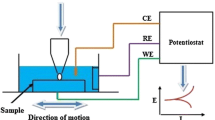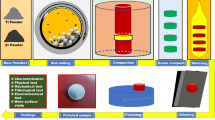Abstract
Titanium–molybdenum-based alloys are widely used as an orthodontic arch wire for performing an orthodontic mechanotherapy. However, the poor tribological behaviour of titanium-based alloys, in terms of high and unstable friction, severe adhesive wear; low resistance to abrasion has become a major setback. Herein, Ti94Mo6Xn(x = Nb, Ta, Zr and Sn) alloys were fabricated by arc melting and the effect of Nb, Ta, Zr and Sn minor-additions on tribological properties of βtype biomedical Ti-alloys in simulated body fluid (Ringer’s SBF solution) was studied. Additionally, the post-test characteristics, and morphology were studied by XRD, pin-on-disk tester, nano-indentation, 3D confocal microscope and scanning electron microscope (SEM). Results showed that anti-friction resistance rate and the extent of anti-wear resistance improved by up to 40% and 43% with Sn and Nb minor addition, respectively. It was exciting that these functionalised Ti–Mo-based alloys had higher friction and wear resistance than the commonly used Ti–6Al–4 V alloys, which can be beneficial for many biomedical applications.





Similar content being viewed by others
Availability of Data and Materials
The authors confirm that the data supporting the findings of this study are available within the article.
References
Niinomi M (2003) Recent research and development in titanium alloys for biomedical applications and healthcare goods. Sci Technol Adv Mater 4:445–454
Geetha M, Singh A, Asokamani R et al (2009) Ti based biomaterials, the ultimate choice for orthopaedic implants—a review. Prog Mater Sci 54(3):397–425
Yu Z, Zhang M, Tian Y, Cheng J, Ma X, Liu H et al (2014) Designation and development of biomedical Ti alloys with finer biomechanical compatibility in long-term surgical implants. Front Mater Sci 8:219–229
Spector M (2016) An auspicious decade for biomedical materials. Biomed Mater. https://doi.org/10.1088/0102011748-6041/11/1/010201
Brunette DM, Texlon PTM, Thompson P (2001) Titanium in medicine. Springer, Berlin
Eisenbarth E, Velten D, Muller M, Thull R, Breme J (2004) Biocompatibility of beta-stabilizing elements of titanium alloys. Biomaterials 25:5705–5713
Nnamchi PS, Njoku RE (2013) Alloy design and property evaluation of Ti-Mo-Nb-Sn alloy for biomedical application. Nigeria J Tech 32:410–416
Narita K, Niinomi M, Nakai M, Hieda J, Oribe K (2012) Development of thermo-mechanical processing for fabricating highly durable β-type Ti–Nb–Ta–Zr rod for use in spinal fixation devices. J Mech Behav Biomed Mater 9:207–216
Nnamchi PS, Todd I, Rainforth WM (2016) Alloy design and characterization of mechanical properties of low Young’s modulus Ti–Mo–Zr–Sn alloy for biomedical application. J Mech behave Biomater 60:68–77
Song Y, Xu DS, Yang R, Li D, Wu WT, Guo ZX (1999) Theoretical study of the effects of alloying elements on the strength and modulus of β-type bio-titanium alloys Mater. Sci Eng A 260:269–274
Elias CN, Lima JHC, Valiev R, Meyers MA (2008) Biomedical applications of titanium and its alloys. JOM 60(3):46–49. https://doi.org/10.1007/s11837-008-0031-1
Higo Y, Ouchi C, Tomita Y, Murota K, Sugiyama H (1994). In: Fujishiro S, Eylon D, Kishi T (eds) Metallurgy and technology of practical titanium alloys. TMS, Warrendale
Sandu AV, Baltatu MS, Nabialek M, Savin A, Vizureanu P (2019) Characterization and Mechanical Proprieties of New TiMo Alloys Used for Medical Applications. Materials 12:2973. https://doi.org/10.3390/ma12182973
Gordin DM, Gloriant T, Nemtoi Gh, Chelariu R, Aelenei N, Guillou A, Ansel D (2005) Mater Lett 59:2959–2964
Ho WF, Ju CP, Chern Lin JH (1999) Structure and properties of cast binary Ti-Mo alloys. Biomaterials 20:2115–2122
Luna Lourenço M et al (2020) Development of novel Ti–Mo–Mn alloys for biomedical applications. Sci Rep 10:6298. https://doi.org/10.1038/s41598-020-62865-4
Moiseev VN, Antipov AI (1995) Aluminium effect on beta-phase stability in beta-titanium alloys. Metallovedenie i Termicheskaya Obrabotka Metallov (9):30–35. ISSN 0026-0819
Moshokoa N, et al (2019) effects of Mo content on the microstructural and mechanical properties of as-cast Ti-Mo alloys. IOP Conf Series Mater Sci Eng 655: 012015. https://doi.org/10.1088/1757-899X/655/1/012015
Rack HJ, Qazi JI (2006) Titanium alloys for biomedical applications. Mater Sci Eng C 26(8):1269–1277. https://doi.org/10.1016/j.msec.2005.08.032
Hao YL, Li SJ, Sun SY, Zheng CY, Hu QM, Yang R (2005) Super elastic titanium alloy with unstable plastic deformation. Appl Phys Lett 87:091906
Injeti VSY, Nune KC, Reyes E, Yue G, Li SJ, Misra RDK (2018) A comparative study on the tribological behavior of Ti-6Al-4V and Ti-24Nb-4Zr-8Sn alloys in simulated body fluid. Mater Technol. https://doi.org/10.1080/10667857.2018.1550138
Majumdar P, Singh SB, Chakraborty M (2008) Wear response of heat-treated Ti-13Zr-13Nb alloy in dry condition and simulated body fluid. Wear 264:1015–1025
Tkachenko S, Datskevich O, Kulak L, Jacobson S, Engqvist H, Persson C (2014) Wear and friction properties of experimental Ti–Si–Zr alloys for biomedical applications. J Mech Behav Biomed Mater 39:61–72. https://doi.org/10.1016/j.jmbbm.2014.07.01
Fellah M, Hezil N, Zine TM, Samad MA, Obrosov A, Bokov DO et al (2020) Structural, tribological and antibacterial properties of (α + β) based Ti-alloys for biomedical applications. J Market Res. https://doi.org/10.1016/j.jmrt.2020.09.118
Funding
There is no funding to report in this work.
Author information
Authors and Affiliations
Contributions
All authors contributed to the design and implementation of the research, to the analysis of the results and to the writing of the manuscript.
Corresponding author
Ethics declarations
Conflict of Interests
There is no competing of interests to report in this work.
Ethical Approval
This work does not include human and animal hence does not require ethical approval from any committee.
Consent to Participate
This work does not include human and animal hence does not require Consent to participate in the research.
Consent to Publish
The authors give the publisher the consent to publish the work.
Additional information
Publisher's Note
Springer Nature remains neutral with regard to jurisdictional claims in published maps and institutional affiliations.
Rights and permissions
Springer Nature or its licensor holds exclusive rights to this article under a publishing agreement with the author(s) or other rightsholder(s); author self-archiving of the accepted manuscript version of this article is solely governed by the terms of such publishing agreement and applicable law.
About this article
Cite this article
Nnamchi, P.S., Aigbodion, V.S. & Obayi, C.S. New Insights on the Tribological Characteristics of Biomedical Ti–Mo Alloys Influenced by Microalloying Addition in Simulated Bodily Fluids. J Bio Tribo Corros 8, 94 (2022). https://doi.org/10.1007/s40735-022-00694-w
Received:
Revised:
Accepted:
Published:
DOI: https://doi.org/10.1007/s40735-022-00694-w




